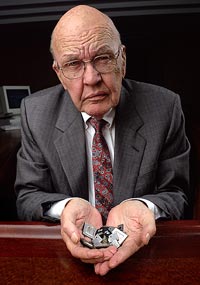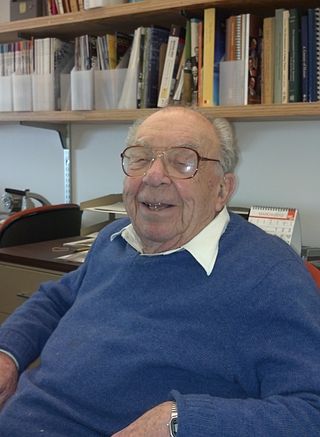
Electrical engineering is an engineering discipline concerned with the study, design, and application of equipment, devices, and systems which use electricity, electronics, and electromagnetism. It emerged as an identifiable occupation in the latter half of the 19th century after the commercialization of the electric telegraph, the telephone, and electrical power generation, distribution, and use.

Jack St. Clair Kilby was an American electrical engineer who took part, along with Robert Noyce of Fairchild Semiconductor, in the realization of the first integrated circuit while working at Texas Instruments (TI) in 1958. He was awarded the Nobel Prize in Physics on 10 December 2000.

In electricity generation, a generator is a device that converts motion-based power or fuel-based power into electric power for use in an external circuit. Sources of mechanical energy include steam turbines, gas turbines, water turbines, internal combustion engines, wind turbines and even hand cranks. The first electromagnetic generator, the Faraday disk, was invented in 1831 by British scientist Michael Faraday. Generators provide nearly all the power for electrical grids.

John Edward Hopcroft is an American theoretical computer scientist. His textbooks on theory of computation and data structures are regarded as standards in their fields. He is a professor emeritus at Cornell University, co-director of the Center on Frontiers of Computing Studies at Peking University, and the director of the John Hopcroft Center for Computer Science at Shanghai Jiao Tong University.

Roberto Mario "Robert" Fano was an Italian-American computer scientist and professor of electrical engineering and computer science at the Massachusetts Institute of Technology. He became a student and working lab partner to Claude Shannon, whom he admired zealously and assisted in the early years of Information Theory.

A homopolar generator is a DC electrical generator comprising an electrically conductive disc or cylinder rotating in a plane perpendicular to a uniform static magnetic field. A potential difference is created between the center of the disc and the rim with an electrical polarity that depends on the direction of rotation and the orientation of the field. It is also known as a unipolar generator, acyclic generator, disk dynamo, or Faraday disc. The voltage is typically low, on the order of a few volts in the case of small demonstration models, but large research generators can produce hundreds of volts, and some systems have multiple generators in series to produce an even larger voltage. They are unusual in that they can source tremendous electric current, some more than a million amperes, because the homopolar generator can be made to have very low internal resistance. Also, the homopolar generator is unique in that no other rotary electric machine can produce DC without using rectifiers or commutators.

Edith Clarke was an American electrical engineer. She was the first woman to be professionally employed as an electrical engineer in the United States, and the first female professor of electrical engineering in the country. She was the first woman to deliver a paper at the American Institute of Electrical Engineers; the first female engineer whose professional standing was recognized by Tau Beta Pi, the oldest engineering honor society and the second oldest collegiate honor society in the United States; and the first woman named as a Fellow of the American Institute of Electrical Engineers. She specialized in electrical power system analysis and wrote Circuit Analysis of A-C Power Systems.
Ernst Adolph Guillemin was an American electrical engineer and computer scientist at the Massachusetts Institute of Technology who spent his career extending the art and science of linear network analysis and synthesis. His nephew Victor Guillemin is a math professor at MIT, his nephew Robert Charles Guillemin was a sidewalk artist, his great-niece Karen Guillemin is a biology professor at the University of Oregon, and his granddaughter Mary Elizabeth Meyerand is a Medical Physics Professor at the University of Wisconsin-Madison.

Russell Conwell Newhouse (1906–1998) made many contributions to the advancement of aviation in a distinguished career running from the late 1920s into the 1970s. He was the Director of the Radar Laboratory for the Bell Telephone Laboratories from 1958 to 1968.
Fritz Herzog was an American mathematician, known for his work in complex analysis and power series.
J. David Irwin is an American engineering educator and author of popular textbooks in electrical engineering and related areas. He is the Earle C. Williams Eminent Scholar and former Electrical and Computer Engineering Department Head at Auburn University. Irwin is one of the longest serving Department Heads of Electrical and Computer Engineering (ECE) in the world, having been appointed to lead the Department at Auburn in 1973. He had also served as President of the ECE honor society Eta Kappa Nu; President of the US National Electrical Engineering Department Head Association; and President of two IEEE technical societies, on Industrial Electronics and on Education.
Sung-Mo "Steve" Kang is an American electrical engineering scientist, professor, writer, inventor, entrepreneur and 15th president of KAIST. Kang was appointed as the second chancellor of the University of California, Merced in 2007. He was the first department head of foreign origin at the electrical and computer engineering department at the University of Illinois at Urbana-Champaign and Dean of the Baskin School of Engineering at UC Santa Cruz. Kang teaches and has written extensively in the field of computer-aided design for electronic circuits and systems; he is recognized and respected worldwide for his outstanding research contributions. Kang has led the development of the world’s first 32-bit microprocessor chips as a technical supervisor at AT&T Bell Laboratories and designed satellite-based private communication networks as a member of technical staff. Kang holds 15 U.S. patents and has won numerous awards for his ground breaking achievements in the field of electrical engineering.
Michel S Nakhla is a Chancellor's Professor at Carleton University and a researcher in Electronic Design Automation. He is the founder of the high-speed CAD research group at Carleton University and is a frequently invited speaker on the topic of high-speed interconnects. He is the first pioneer to introduce the concept of harmonic balance, which is the backbone of current RF and microwave circuit simulators. He was awarded the IEEE Fellowship in 1998 for his contributions to the development of advanced computer-aided design techniques for microwave circuits and high-speed interconnects. He has authored and co-authored over 300 technical papers that contributed significantly to the evolution of the Design Automation field.

Anthony N. Michel, a life fellow of the Institute of Electrical and Electronics Engineers, was an American engineering educator. His expertise was in qualitative analysis of dynamical systems with emphasis on stability theory and applications.

Levent Gürel is a Turkish scientist and electrical engineer. He was the director of Computational Electromagnetics Research Center (BiLCEM) and a professor in the Department of Electrical and Electronics Engineering at the Bilkent University, Turkey until November 2014. Currently, he is serving as an adjunct professor at the University of Illinois Urbana-Champaign, Department of Electrical and Computer Engineering. He is also serving as the founder and CEO of ABAKUS Computing Technologies.
Stephen P. Boyd is an American professor and control theorist. He is the Samsung Professor of Engineering, Professor in Electrical Engineering, and professor by courtesy in Computer Science and Management Science & Engineering at Stanford University. He is also affiliated with Stanford's Institute for Computational and Mathematical Engineering (ICME).
Mangalore Anantha Pai was an Indian electrical engineer, academic and a Professor Emeritus at the University of Illinois at Urbana–Champaign. A former professor of electrical engineering at the Indian Institute of Technology, Kanpur, he is known for his contributions in the fields of power stability, power grids, large scale power system analysis, system security and optimal control of nuclear reactors and he has published 8 books and several articles. Pai is the first India born scientist to be awarded a PhD in Electrical Engineering from the University of California, Berkeley.

Weng Cho Chew is a Malaysian-American electrical engineer and applied physicist known for contributions to wave physics, especially computational electromagnetics. He is a Distinguished Professor of Electrical and Computer Engineering at Purdue University.
Lawrence Pileggi is the Coraluppi Head and Tanoto Professor of Electrical and Computer Engineering at Carnegie Mellon University. He is a specialist in the automation of integrated circuits, and developing software tools for the optimization of power grids. Pileggi's research has been cited thousands of times in engineering papers.
Arthur Aaron Oliner was an American physicist and electrical engineer, who was professor emeritus at department of electrical and computer engineering at New York University-Polytechnic. Best known for his contributions to engineering electromagnetics and antenna theory, he is regarded as a pioneer of leaky wave theory and leaky wave antennas.